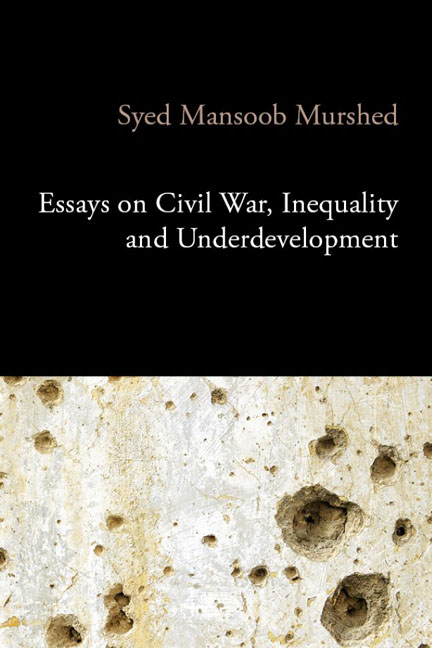Book contents
- Frontmatter
- Contents
- Preface
- Tables and figures
- 1 Conflict, civil war and underdevelopment
- 2 Revisiting the greed and grievance explanations for violent conflict
- 3 Greed, grievance and globalization
- 4 Economic dimensions of the liberal peace and its implications for conflict in developing countries
- 5 Enforcing peace agreements through commitment technologies
- 6 The conflict–growth nexus and the poverty of nations
- 7 Conflict and fiscal capacity
- 8 Does civil war hamper financial development?
- 9 The clash of civilizations and the interaction between fear and hatred
- 10 Transnational terrorism as a spillover of domestic disputes in other countries
- 11 Quantitative restrictions on the flow of narcotics: supply and demand restraints in a North–South macro-model
- 12 Spatial-horizontal inequality and the Maoist conflict in Nepal
- 13 Socioeconomic determinants of everyday violence in Indonesia: an empirical investigation of Javanese districts, 1994–2003
- 14 Not loving thy neighbour as thyself: trade, democracy and military expenditure explanations underlying India–Pakistan rivalry
- Acknowledgements
- References
- Index
14 - Not loving thy neighbour as thyself: trade, democracy and military expenditure explanations underlying India–Pakistan rivalry
Published online by Cambridge University Press: 09 January 2024
- Frontmatter
- Contents
- Preface
- Tables and figures
- 1 Conflict, civil war and underdevelopment
- 2 Revisiting the greed and grievance explanations for violent conflict
- 3 Greed, grievance and globalization
- 4 Economic dimensions of the liberal peace and its implications for conflict in developing countries
- 5 Enforcing peace agreements through commitment technologies
- 6 The conflict–growth nexus and the poverty of nations
- 7 Conflict and fiscal capacity
- 8 Does civil war hamper financial development?
- 9 The clash of civilizations and the interaction between fear and hatred
- 10 Transnational terrorism as a spillover of domestic disputes in other countries
- 11 Quantitative restrictions on the flow of narcotics: supply and demand restraints in a North–South macro-model
- 12 Spatial-horizontal inequality and the Maoist conflict in Nepal
- 13 Socioeconomic determinants of everyday violence in Indonesia: an empirical investigation of Javanese districts, 1994–2003
- 14 Not loving thy neighbour as thyself: trade, democracy and military expenditure explanations underlying India–Pakistan rivalry
- Acknowledgements
- References
- Index
Summary
Introduction
This chapter examines inter-state hostility between India and Pakistan, which is arguably one of the most prominent inter-state conflicts still extant, whose saliency is highlighted by the presence of nuclear weapons on both sides. Conflict reduction is also necessary if the region is to release resources from military expenditure for poverty reduction. We analyse some of the factors that might lead to conflict abatement between these long-standing rivals, including the role of trade and a mutually democratic orientation. In doing so, we hope to utilize this important case of bilateral inter-state conflict to shed some light on the voluminous liberal peace literature.
India and Pakistan emerged as separate nation states in August 1947, when British India was partitioned following independence from colonial rule. Latterly, in 1971, the Eastern wing of Pakistan separated to become Bangladesh. In many ways, India and Pakistan share a common heritage, including overlapping languages and ethnicities, as two major provinces of British India were split up in the partition process (Punjab and Bengal). The ostensibly differentiating factor is religion; although Pakistan is predominantly Muslim, up to 10 per cent of India's population continues to be Muslim, and as much as 15 per cent of Bangladesh's population is non-Muslim.
The hostility between India and Pakistan dates back to the very inception of these countries as independent states. They have had six wars or fatal conflicts; three over the disputed territory of Kashmir in 1947‒48, 1965 and 1999, the Rann of Kutch in 1965, one in connection with the secession of Bangladesh in 1971, and sporadic fighting over the uncharted Siachen Glaciers in the 1980s. The territorial dispute over Kashmir remains unresolved. Even when they are not engaged in outright war, Indian and Pakistani troops confront each other every day, with fingers literally on the trigger, along the ceasefire line or line of control established on 1 January 1949 in Kashmir. India also unilaterally amassed troops more generally along the Pakistan border in 1951 and 2002. India has, with considerable justification, accused Pakistan of fomenting, aiding and abetting the insurgency in Indian Kashmir since 1989, and wider acts of terrorism inside India (with less justification).
- Type
- Chapter
- Information
- Essays on Civil War, Inequality and Underdevelopment , pp. 243 - 266Publisher: Agenda PublishingPrint publication year: 2021



